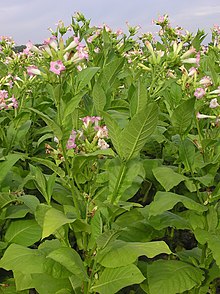Anabasine
| Structural formula | |||||||||||||||||||
|---|---|---|---|---|---|---|---|---|---|---|---|---|---|---|---|---|---|---|---|

|
|||||||||||||||||||
| General | |||||||||||||||||||
| Surname | Anabasine | ||||||||||||||||||
| other names |
|
||||||||||||||||||
| Molecular formula | C 10 H 14 N 2 | ||||||||||||||||||
| Brief description |
colorless to yellowish liquid |
||||||||||||||||||
| External identifiers / databases | |||||||||||||||||||
|
|||||||||||||||||||
| properties | |||||||||||||||||||
| Molar mass | 162.23 g mol −1 | ||||||||||||||||||
| Physical state |
liquid |
||||||||||||||||||
| density |
1.05 g cm −3 (20 ° C) |
||||||||||||||||||
| Melting point |
9 ° C |
||||||||||||||||||
| boiling point |
270-272 ° C |
||||||||||||||||||
| Vapor pressure |
3 h Pa (105 ° C) |
||||||||||||||||||
| solubility |
miscible with water and most organic solvents |
||||||||||||||||||
| Refractive index |
1.5430 (20 ° C) |
||||||||||||||||||
| safety instructions | |||||||||||||||||||
|
|||||||||||||||||||
| As far as possible and customary, SI units are used. Unless otherwise noted, the data given apply to standard conditions . Refractive index: Na-D line , 20 ° C | |||||||||||||||||||
Anabasine is a chemical compound from the group of alkaloids . The compound consists of a pyridine and a piperidine ring, the piperidine ring having a stereocenter . It is structurally related to nornicotine , which has a ring narrower by one methylene group , and anatabine , whose piperidine ring has a double bond .
Occurrence
The L -form of anabasin could be detected in tobacco plants as well as in tobacco smoke .
properties
Anabasin is a yellowish liquid. It is a chiral compound that occurs naturally in tobacco plants as the ( S ) enantiomer . Anabasin has a toxic effect and, depending on the enantiomer, has a lethal dose (administered intravenously) of 11 mg / kg or 16 mg / kg in mice.
It belongs to the group of nicotinic acetylcholine receptor agonists and, in sufficient doses, can cause symptoms similar to nicotine poisoning . This can lead to death from cardiac arrest .
Individual evidence
- ↑ a b c d e f g Entry on anabasine in the GESTIS substance database of the IFA , accessed on February 1, 2016(JavaScript required) .
- ^ The Merck Index . An Encyclopaedia of Chemicals, Drugs and Biologicals . 14th edition, 2006, p. 99, ISBN 978-0-911910-00-1 .
- ↑ David R. Lide (Ed.): CRC Handbook of Chemistry and Physics . 90th edition. (Internet version: 2010), CRC Press / Taylor and Francis, Boca Raton, FL, Physical Constants of Organic Compounds, pp. 3-436.
- ↑ E. Späth, F. Kesztler: About the occurrence of d, l-nor-nicotine, d, l-anatabine and l-anabasine in tobacco (XII. Communication on tobacco alkaloids) , in: Chem. Ber. 1937 , 70 , 4, 704-709; doi: 10.1002 / cber.19370700421 .
- ↑ P. Jacob, L. Yu, AT Shulgin, NL Benowitz: Minor tobacco alkaloids as biomarkers for tobacco use: comparison of users of cigarettes, smokeless tobacco, cigars, and pipes , in: Am. J. Public Health 1999 , 89 , 731-736.
- ↑ E. Broad Maier: Alkaloids: narcotics, hallucinogens and other drugs, lead compounds from nature , Vieweg + Teubner Verlag, 3rd edition, 2008, p 31: ISBN 3-8348-0531-9 .
- ↑ L. Stephen, K. Wildeboer, K. Panter, W. Kem, F. Gardner, R. Molyneux, C.–W. Chang, F. Soti, J. Pfister: Relative Toxicities and Neuromuscular Nicotinic Receptor Agonistic Potencies of Anabasine Enantiomers and Anabaseine in: Neurotoxicology and Teratology , 2006 .
- ^ N. Mizrachi, S. Levy, Z. Goren: Fatal poisoning from nicotiana glauca leaves: identification of anabasine by gas-chromatography / mass spectrometry , in: Journal of Forensic Sciences 2000 , 45 , 736-741.


